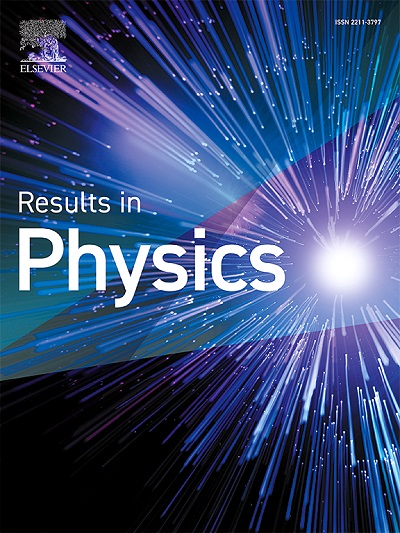二维Janus SbXI (X=S, Se, Te)单层的应变可调电子、光学和热电性质:第一性原理研究
IF 4.4
2区 物理与天体物理
Q2 MATERIALS SCIENCE, MULTIDISCIPLINARY
引用次数: 0
摘要
探索新的、原子薄的、稳定的二维(2D)材料仍然是一个重要而活跃的研究领域,推动了当代材料研究的基础科学和实际应用的进步,特别是在电子、热电和光学领域。通过第一性原理密度泛函理论(DFT)计算,系统地研究了三种半导体Janus单层:SbSI, SbSeI和SbTeI。综合分析表明,该方法具有良好的动力稳定性和能量稳定性,表明了机械剥离实验实现的可行性。电子结构计算表明,使用PBE (HSE06)官能团,SbSI、SbSeI和SbTeI的间接带隙分别为1.57(2.12)、1.30(1.80)和1.22 (1.64)eV,其中SbSeI单层的电子迁移率为213.96 cm2V−1s−1,超过了已建立的MoS2。值得注意的是,在800 K时,SbSeI单层具有出色的热电性能,其优点系数(ZT)为5.39,晶格导热系数为0.14 W/mK。此外,当施加+8%的双轴应变时,SbTeI单层膜显示出显著的光学性能,包括在紫外区(~ 250 nm)具有64.00%的高反射率和121.98 × 104 cm−1的吸收系数。这些发现强调了Janus SbXI (X = S, Se, Te)单层在下一代能量转换应用中的巨大潜力,为有效的能量收集和热管理提供了有前途的途径,同时在纳米级光学器件中实现了新功能。本文章由计算机程序翻译,如有差异,请以英文原文为准。

Strain-tunable electronic, optical and thermoelectric properties of two-dimensional Janus SbXI (X=S, Se, Te) monolayers: A first-principles study
The exploration of novel, atomically thin, and stable two-dimensional (2D) materials remains an important and active area of study, driving progress in both fundamental science and practical applications within contemporary materials research, particularly in electronic, thermoelectric, and optical domains. Through first-principles density functional theory (DFT) calculations, Three semiconducting Janus monolayers was systematically investigated: SbSI, SbSeI and SbTeI. The comprehensive analysis demonstrates excellent dynamical and energetic stability, indicating the feasibility of mechanical exfoliation for experimental realization. Electronic structure calculations reveal indirect bandgaps of 1.57 (2.12), 1.30 (1.80), and 1.22 (1.64) eV for SbSI, SbSeI, and SbTeI, respectively, using PBE (HSE06) functionals, with the SbSeI monolayer exhibiting an exceptional electron mobility of 213.96 cmV−1s−1, surpassing that of the well-established MoS. Remarkably, at 800 K, the SbSeI monolayer achieves outstanding thermoelectric performance, characterized by a figure of merit () of 5.39, facilitated by an ultralow lattice thermal conductivity of 0.14 W/mK. Furthermore, upon application of +8% biaxial strain, the SbTeI monolayer displays notable optical properties, including a high reflectivity of 64.00% in the ultraviolet region ( 250 nm) and an absorption coefficient of 121.98 × 10 cm−1. These findings underscore the significant potential of Janus SbXI (X = S, Se, Te) monolayers for next-generation energy conversion applications, offering promising avenues for efficient energy harvesting and thermal management while enabling novel functionalities in nanoscale optical devices.
求助全文
通过发布文献求助,成功后即可免费获取论文全文。
去求助
来源期刊

Results in Physics
MATERIALS SCIENCE, MULTIDISCIPLINARYPHYSIC-PHYSICS, MULTIDISCIPLINARY
CiteScore
8.70
自引率
9.40%
发文量
754
审稿时长
50 days
期刊介绍:
Results in Physics is an open access journal offering authors the opportunity to publish in all fundamental and interdisciplinary areas of physics, materials science, and applied physics. Papers of a theoretical, computational, and experimental nature are all welcome. Results in Physics accepts papers that are scientifically sound, technically correct and provide valuable new knowledge to the physics community. Topics such as three-dimensional flow and magnetohydrodynamics are not within the scope of Results in Physics.
Results in Physics welcomes three types of papers:
1. Full research papers
2. Microarticles: very short papers, no longer than two pages. They may consist of a single, but well-described piece of information, such as:
- Data and/or a plot plus a description
- Description of a new method or instrumentation
- Negative results
- Concept or design study
3. Letters to the Editor: Letters discussing a recent article published in Results in Physics are welcome. These are objective, constructive, or educational critiques of papers published in Results in Physics. Accepted letters will be sent to the author of the original paper for a response. Each letter and response is published together. Letters should be received within 8 weeks of the article''s publication. They should not exceed 750 words of text and 10 references.
 求助内容:
求助内容: 应助结果提醒方式:
应助结果提醒方式:


